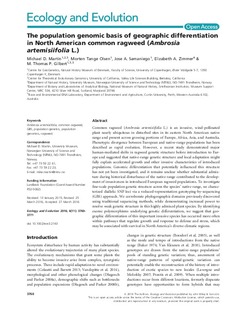| dc.contributor.author | Martin, Michael D | |
| dc.contributor.author | Olsen, Morten T | |
| dc.contributor.author | Samaniego, Jose | |
| dc.contributor.author | Zimmer, Elizabeth A | |
| dc.contributor.author | Gilbert, Marcus Thomas Pius | |
| dc.date.accessioned | 2020-03-05T13:42:40Z | |
| dc.date.available | 2020-03-05T13:42:40Z | |
| dc.date.created | 2016-06-14T13:47:17Z | |
| dc.date.issued | 2016 | |
| dc.identifier.citation | Ecology and Evolution. 2016, 6 (11), 3760-3771. | nb_NO |
| dc.identifier.issn | 2045-7758 | |
| dc.identifier.uri | http://hdl.handle.net/11250/2645540 | |
| dc.description.abstract | Common ragweed (Ambrosia artemisiifolia L.) is an invasive, wind‐pollinated plant nearly ubiquitous in disturbed sites in its eastern North American native range and present across growing portions of Europe, Africa, Asia, and Australia. Phenotypic divergence between European and native‐range populations has been described as rapid evolution. However, a recent study demonstrated major human‐mediated shifts in ragweed genetic structure before introduction to Europe and suggested that native‐range genetic structure and local adaptation might fully explain accelerated growth and other invasive characteristics of introduced populations. Genomic differentiation that potentially influenced this structure has not yet been investigated, and it remains unclear whether substantial admixture during historical disturbance of the native range contributed to the development of invasiveness in introduced European ragweed populations. To investigate fine‐scale population genetic structure across the species' native range, we characterized diallelic SNP loci via a reduced‐representation genotyping‐by‐sequencing (GBS) approach. We corroborate phylogeographic domains previously discovered using traditional sequencing methods, while demonstrating increased power to resolve weak genetic structure in this highly admixed plant species. By identifying exome polymorphisms underlying genetic differentiation, we suggest that geographic differentiation of this important invasive species has occurred more often within pathways that regulate growth and response to defense and stress, which may be associated with survival in North America's diverse climatic regions. | nb_NO |
| dc.language.iso | eng | nb_NO |
| dc.publisher | Wiley Open Access | nb_NO |
| dc.rights | Navngivelse 4.0 Internasjonal | * |
| dc.rights.uri | http://creativecommons.org/licenses/by/4.0/deed.no | * |
| dc.title | The population genomic basis of geographic differentiation in North American common ragweed (Ambrosia artemisiifolia L.) | nb_NO |
| dc.type | Journal article | nb_NO |
| dc.type | Peer reviewed | nb_NO |
| dc.description.version | publishedVersion | nb_NO |
| dc.source.pagenumber | 3760-3771 | nb_NO |
| dc.source.volume | 6 | nb_NO |
| dc.source.journal | Ecology and Evolution | nb_NO |
| dc.source.issue | 11 | nb_NO |
| dc.identifier.doi | 10.1002/ece3.2143 | |
| dc.identifier.cristin | 1361451 | |
| dc.description.localcode | © 2016 The Authors. Ecology and Evolution published by John Wiley & Sons Ltd. This is an open access article under the terms of the Creative Commons Attribution License, which permits use, distribution and reproduction in any medium, provided the original work is properly cited. | nb_NO |
| cristin.unitcode | 194,31,10,0 | |
| cristin.unitname | Institutt for naturhistorie | |
| cristin.ispublished | true | |
| cristin.fulltext | original | |
| cristin.qualitycode | 1 | |

